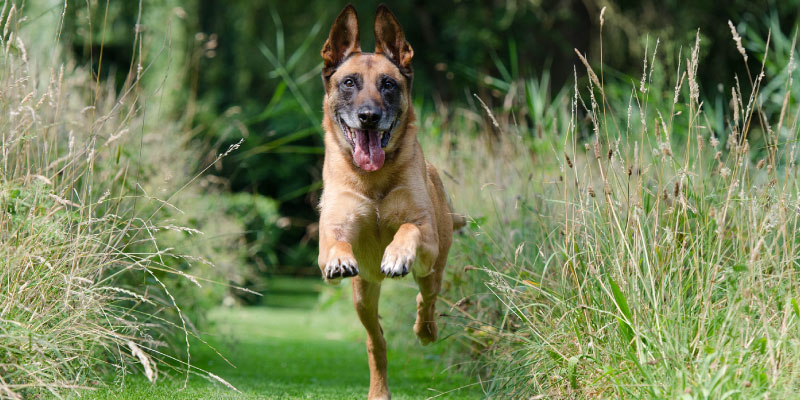Whether yours is an Olympic athlete or a shy couch-dweller, try our top tips to on how to get your dog fit.
We all love to think of our dog as a boundless ball of energy who will follow us wherever we go.
However, for whatever reason – age, ailments or general lifestyle – that’s not always the case. Much like us, the older our dog gets, the easier it will be for them to get a little slower and a little lazier.

And just like us, you can build up their tolerance to more exercise slowly, but surely, not just so you can take them along on adventurous activities, but for their general health and well-being.
How to get a dog fit – starting from the beginning
Your dog may have less than average fitness levels for any number of reasons, for example:
- Not enough exercise
- Social anxiety (see our tips on how to socialise dogs)
- Age (puppies should be exercised less as they are growing, older dogs may have less stamina)
- Stiffness caused by prior illness
If your pooch falls into any one of the above categories, the first thing to do is to consult with your vet.
It may be worth going for a general check-up to make sure your dog doesn’t have any underlying health issues, such as heart problems or reduced mobility before you start any fitness regime.
How else your vet can help
In addition to discussing dog fitness, your vet can also guide you on a nutritional plan.
Generally speaking, it’s best to stick to premium brands that don’t use fillers to bulk out the product.
These will ensure your dog’s digestive system functions as well as it can. You should also keep an eye on daily calorie limits for your pup and stop any treats that aren’t designed for dogs – no more scraps from the dining room table.
Another great benefit of getting regular trips to the vet is their weighing scales. Getting your dog’s weight right, especially if it’s a larger breed, is difficult without medical equipment.
It’s also a key indicator of your dog’s health, so make sure you tick all of these off before you start with a dog fitness program.
Small exercises for unfit dogs
Building up a fitness plan will take patience with less fit dogs. So, start small and combine it with your own activities. Got a letter to post? Have a five-minute walk with your dog and slowly progress to 10-minute walk.
Most dog should be comfortable with those distance, but if yours is a particularly lazy pup, sort small and build up.
Often, the hardest step is getting a lazy dog out of the house! This comes down to conditioning – ideally, you need to incentivise your dog without encouraging it to eat treats. This could be something as simple as conditioning your pup to walk outside to the dustbin with you, or taking a little job back and forth in the back garden.
Increase the bond with a tug of war
Getting your pup to walk alongside you is one thing – it’s another to connect with them through a little one on one! A tug of war with an approved chew toy is great for doing this. Start by lining up your dog’s neck and back to keep the spine safe. Do not resist – let the dog pull the toy. This will help to increase your dog’s strength, plus allay any bad behavioural tendencies like chewing furniture.
Play fetch
After a few days of building up the two exercises above, you can progress to playing fetch. Start by throwing the ball a very short distance – perhaps practise indoors first (where it is safe to do so!) and then try outside. This is also a great way to train up your dog in commands, which will work for when fitness improves. Your dog will be far more willing to exercise if he sees it as a game rather than a chore.
More exercises for fit dogs
If your dog is generally fit and is already happy to play tug of war or they can fetch for 20 minutes in a row without stopping, it’s time to move on to our section ‘how to get a dog fit’ below.
How to measure your dog’s fitness
After four or five weeks on this routine, check in with your vet. It may be time to upgrade your canine workout program. Before you start, you should take a look at your dog’s health and fitness in general. Make a mental note of how long your dog could run/walk for when you started before panting, and compare it to now.
Ask your vet to weigh the dog, and keep your eyes open for any changes in attitude. Is your pooch happier to exercise now? If you want to be really technical, you can even use dog fitness trackers – great for sticking to your dog’s collar and analysing later. An added bonus: they might help you improve your fitness too!
How to get a dog fit
So now that your dog is comfortable, you’re probably looking for how to make your dog fit for more ambitious activities – long walks, bike rides and hikes, for example. You need to consider not just your dog’s cardiovascular health, but the strength in its body and legs.
Dog circuit training
It sounds laughable, but there are many dog workouts that go beyond the standard walk! Try the following exercises outside in the park or at home if you’ve got more room.
- Cone weaves – line up a few small game cones and run around them with your dog to improve speed and agility.
- Step-ups – use a makeshift step such as a pile of books or even your own exercise step. If you can, line a few up and jump over them with the dog to strengthen the back legs.
- Sit, stay and squat – you’ll need the cones again. You can also test your dog’s obedience. Lie out two cones a fair distance from one another. Run to one and tell your pup to sit while you squat. Repeat back and forth until you’re both tired!
Hill training
Once you’re comfortable walking with your pooch, you can amplify your dog fitness training routine with a light jog. Plan a route using tools like Gmaps Pedometer. Here you can incorporate small hills to build up your pup’s endurance. Try going a little higher up the hill every week.
Are you ready to run?
You don’t have to run a marathon with your dog. How long and how much a healthy and fit dog can run, walk or be outside will depend on the breed.
With an overweight dachshund, you’ll need to start small, with short 5 to 10 minutes walks, but an overweight Labrador Retriever should be able to get out and about for 20 minutes.
Once you get them at a good fitness levels. The dachshund will be happy to go for 60 minutes walks, if not more, as you increase their fitness level. But they will probably never be able to cycle along with you or do great distance running.
The Labrador Retriever, on the other hand, if he’s generally fit, healthy, and of the right age (not too young, not too old), could happily run with you the whole day long.
We’ve even written a more aggressive running program with your dog if you are looking to embark on a more active regime with a breed appropriate dog.
Can you help a nervous dog get fit?
At the end of the day, you need to work with the personality of your pooch as much as your own.
If you live in the city and your pooch is scared if cars, you will need to deal with that anxiety first before you can reasonably start training with them outside your home.
Remember that everything you do with your dog, from playing, to teaching them tricks, to the love you give them, with help them build up confidence and their bond with you. Build that first, and eventually, you may find that they are a little less nervous stepping out the door with you.
You may have to start slow. Simply sit in your doorstep and watch people go by and you stroke your pooch. Then go a little further our of your driveway. Work with your dog, give them treats the braver they are, but don’t push them or force them to the point of distress. This will inevitably make it a bad experience and you’ll make a bad situation worse.
Let your dog be your training partner
In the same way, if your dog has a tendency to wander, is stubborn, independent, or is easily distracted, you may need to find a dog training program that suits you both, or get specialised equipment.
Maybe that’s a GPS tracking on their collar for when they chase that squirrel a little too far away from you. Maybe it’s simply getting a hip leash so they learn to run alongside you, rather than ahead of you.
Ultimately, most healthy dog breeds can run much faster and further than most humans. You’ll find that once you start training them up, you’ll be trying to keep up with them rather than the other way around.
OK… maybe not some breeds such as Pugs or Bulldogs, but even a small Papillon dog could run 3 miles once or twice a week with you.
And even then, with small dog breeds, just need to bring a solid dog carrier with you to help them when their little legs get a tired.
Going out into the big bad world
Once your dog can comfortably train with you (which you can measure by taking it on runs of two to six miles), it’s time to get out there! Consider a camping trip where you can do hiking trails, or investing in a bike leash to take your dog on longer walks.
Remember, you should always get an assessment from your vet before you embark on a new regime. Puppy fitness is particularly important as younger dogs do not have the stamina for hours-long walks.
With a little encouragement, you can turn a lazy or shy dog into an active and happy pup. Keep an eye on your dog’s health and look at your own, too. You could even make yourself healthier as your dog’s fitness begins to increase.
A dog will never give you any excuses to stay home, so there’s no reason why you and your pup can’t get out running, walking or hiking! From less anxiety to a longer lifespan, there are so many benefits to getting your dog fit and healthy.




